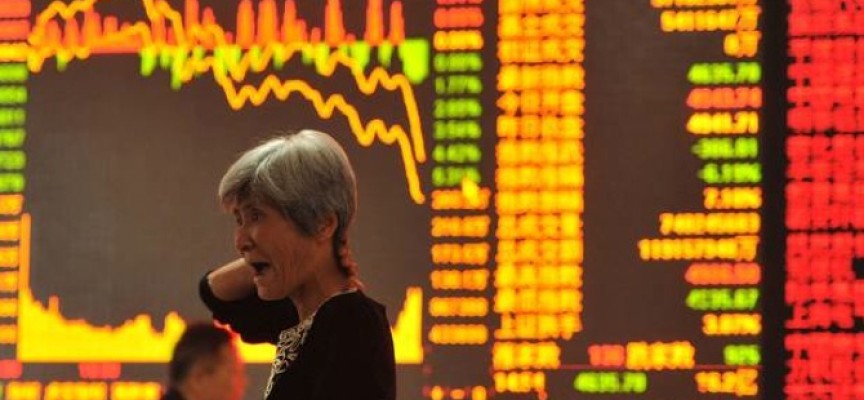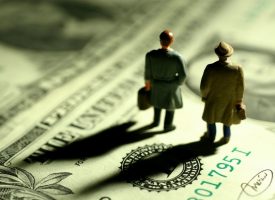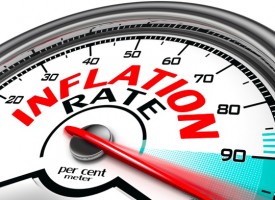With the Dow tumbling another 450 points, this is the real reason markets are crashing.
May 20 (King World News) – Alasdair Macleod: Central bankers’ narratives are falling apart. And faced with unpopularity over rising prices politicians are beginning to question central bank independence. Driven by the groupthink coordinated in the regular meetings at the Bank for International Settlements, they became collectively blind to the policy errors of their own making.
On several occasions I have written about the fallacies behind interest rate policies. I have written about the lost link between the quantity of currency and credit in circulation and the general level of prices. I have written about the effect of changing preferences between money and goods and the effect on prices.
This article gets to the heart of why central banks’ monetary policy was originally flawed. The fundamental error is to regard economic cycles as originating in the private sector when they are the consequence of fluctuations in credit, to which we can add the supposed benefits of continual price inflation.
Introduction
Many investors swear by cycles. Unfortunately, there is little to link these supposed cycles to economic theory, other than the link between the business cycle and the cycle of bank credit. The American economist Irving Fisher got close to it with his debt-deflation theory by attributing the collapse of bank credit to the 1930s’ depression.
Fisher’s was a well-argued case by the father of modern monetarism. But any further research by mainstream economists was brushed aside by the Keynesian revolution which simply argued that recessions, depressions, or slumps were evidence of the failings of free markets requiring state intervention. Neither Fisher nor Keynes appeared to be aware of the work being done by economists of the Austrian school, principally that of von Mises and Hayek. Fisher was on the American scene probably too early to have benefited from their findings, and Keynes was, well, Keynes the statist who in common with other statists in general placed little premium on the importance of time and its effects on human behaviour.
It makes sense, therefore, to build on the Austrian case, and to make the following points at the outset:
- It is incorrectly assumed that business cycles arise out of free markets. Instead, they are the consequence of the expansion and contraction of unsound money and credit created by the banks and the banking system.
- The inflation of bank credit transfers wealth from savers and those on fixed incomes to the banking sector’s favoured customers. It has become a major cause of increasing disparities between the wealthy and the poor.
- The credit cycle is a repetitive boom-and-bust phenomenon, which historically has been roughly ten years in duration. The bust phase is the market’s way of eliminating unsustainable debt, created through credit expansion. If the bust is not allowed to proceed, trouble accumulates for the next credit cycle.
- Today, economic distortions from previous credit cycles have accumulated to the point where only a small rise in interest rates will be enough to trigger the next crisis. Consequently, central banks have very little room for manoeuvre in dealing with current and future price inflation.
- International coordination of monetary policies has increased the potential scale of the next credit crisis, and not contained it as the central banks mistakenly believe.
- The unwinding of the massive credit expansion in the Eurozone following the creation of the euro is an additional risk to the global economy. Comparable excesses in the Japanese monetary system pose a similar threat.
- Central banks will always fail in using monetary policy as a management tool for the economy. They act for the state, and not for the productive, non-financial private sector.
Modern monetary assumptions
The original Keynesian policy behind monetary and fiscal stimulation was to help an economy recover from a recession by encouraging extra consumption through bank credit expansion and government deficits funded by inflationary means. Originally, Keynes did not recommend a policy of continual monetary expansion, because he presumed that a recession was the result of a temporary failure of markets which could be remedied by the application of deficit spending by the state. The error was to fail to understand that the cycle is of credit itself, the consequence being the imposition of boom and bust on what would otherwise be a non-cyclical economy, where the random action by businesses in a sound money environment allowed for an evolutionary process delivering economic progress.
It was this environment which Schumpeter described as creative destruction. In a sound money regime, businesses deploy the various forms of capital at their disposal in the most productive, profitable way in a competitive environment. Competition and failure of malinvestment provide the best returns for consumers, delivering on their desires and demands. Any business not understanding that the customer is king deserves to fail.
The belief in monetary and fiscal stimulation wrongly assumes, among other things, that there are no intertemporal effects. As long ago as 1730, Richard Cantillon described how the introduction of new money into an economy affected prices. He noted that when new money entered circulation, it raised the prices of the goods first purchased. Subsequent acquirers of the new money raised the prices of the goods they demanded, and so on. In this manner, the new money is gradually distributed, raising prices as it is spent, until it is fully absorbed in the economy. Consequently, maximum benefit of the purchasing power of the new money accrues to the first receivers of it, in his time being the gold and silver imported by Spain from the Americas. But today it is principally the banks that create unbacked credit out of thin air, and their preferred customers who benefit most from the expansion of bank credit. The losers are those last to receive it, typically the low-paid, the retired, the unbanked and the poor, who find that their earnings and savings buy less in consequence.
There is, in effect, a wealth transfer from the poorest in society to the banks and their favoured customers. Modern central banks seem totally oblivious of this effect, and the Bank of England has even gone to some trouble to dissuade us of it, by quoting marginal changes in the Gini coefficient, which as an average tells us nothing about how individuals, or groups of individuals are affected by monetary debasement.
At the very least, we should question central banking’s monetary policies on grounds of both efficacy and the morality, which by debauching the currency, transfers wealth from savers to profligate borrowers —including the government. By pursuing the same monetary policies, all the major central banks are tarred with this bush of ignorance, and they are all trapped in the firm clutch of groupthink gobbledegook.
The workings of a credit cycle
To understand the relationship between the cycle of credit and the consequences for economic activity, A description of a typical credit cycle is necessary, though it should be noted that individual cycles can vary significantly in the detail.
We shall take the credit crisis as our starting point in this repeating cycle. Typically, a credit crisis occurs after the central bank has raised interest rates and tightened lending conditions to curb price inflation, always the predictable result of earlier monetary expansion. This is graphically illustrated in Figure 1. The severity of the crisis is set by the amount of excessive private sector debt financed by bank credit relative to the overall economy. Furthermore, the severity is increasingly exacerbated by the international integration of monetary policies. While the 2007-2008 crises in the UK, the Eurozone and Japan were to varying degrees home-grown, the excessive speculation in the American residential property market, facilitated additionally by off-balance sheet securitisation invested in by the global banking network led to the crisis in each of the other major jurisdictions being more severe than it might otherwise have been.
By acting as lender of last resort to the commercial banks, the central bank tries post-crisis to stabilise the economy. By encouraging a revival in bank lending, it seeks to stimulate the economy into recovery by reducing interest rates. However, it inevitably takes some time before businesses, mindful of the crisis just past, have the confidence to invest in production. They will only respond to signals from consumers when they in turn become less cautious in their spending. Banks, who at this stage will be equally cautious over their lending, will prefer to invest in short-maturity government bonds to minimise balance sheet risk.
A period then follows during which interest rates remain suppressed by the central bank below their natural rate. During this period, the central bank will monitor unemployment, surveys of business confidence, and measures of price inflation for signs of economic recovery. In the absence of bank credit expansion, the central bank is trying to stimulate the economy, principally by suppressing interest rates and more recently by quantitative easing.
Eventually, suppressed interest rates begin to stimulate corporate activity, as entrepreneurs utilise a low cost of capital to acquire weaker rivals, and redeploy underutilised assets in target companies. They improve their earnings by buying in their own shares, often funded by cheapened bank credit, as well as by undertaking other financial engineering actions. Larger businesses, in which the banks have confidence, are favoured in these activities compared with SMEs, who find it generally difficult to obtain finance in the early stages of the recovery phase. To that extent, the manipulation of money and credit by central banks ends up discriminating against entrepreneurial smaller companies, delaying the recovery in employment.
Consumption eventually picks up, fuelled by credit from banks and other lending institutions, which will be gradually regaining their appetite for risk. The interest cost on consumer loans for big-ticket items, such as cars and household goods, is often lowered under competitive pressures, stimulating credit-fuelled consumer demand. The first to benefit from this credit expansion tend to be the better-off creditworthy consumers, and large corporations, which are the early receivers of expanding bank credit.
The central bank could be expected to raise interest rates to slow credit growth if it was effectively managing credit. However, the fall in unemployment always lags in the cycle and is likely to be above the desired target level. And price inflation will almost certainly be below target, encouraging the central bank to continue suppressing interest rates. Bear in mind the Cantillon effect: it takes time for expanding bank credit to raise prices throughout the country, time which contributes to the cyclical effect.
Even if the central bank has raised interest rates by this stage, it is inevitably by too little. By now, commercial banks will begin competing for loan business from large credit-worthy corporations, cutting their margins to gain market share. So, even if the central bank has increased interest rates modestly, at first the higher cost of borrowing fails to be passed on by commercial banks.
With non-financial business confidence spreading outwards from financial centres, bank lending increases further, and more and more businesses start to expand their production, based upon their return-on-equity calculations prevailing at artificially low interest rates and input prices, which are yet to reflect the increase in credit. There’s a gathering momentum to benefit from the new mood. But future price inflation for business inputs is usually underestimated. Business plans based on false information begin to be implemented, growing financial speculation is supported by freely available credit, and the conditions are in place for another crisis to develop.
Since tax revenues lag in any economic recovery, government finances have yet to benefit suvstantially from an increase in tax revenues. Budget deficits not wholly financed by bond issues subscribed to by the domestic public and by non-bank corporations represents an additional monetary stimulus, fuelling the credit cycle even more at a time when credit expansion should be at least moderated.
For the planners at the central banks, the economy has now stabilised, and closely followed statistics begin to show signs of recovery. At this stage of the credit cycle, the effects of earlier monetary inflation start to be reflected more widely in rising prices. This delay between credit expansion and the effect on prices is due to the Cantillon effect, and only now it is beginning to be reflected in the calculation of the broad-based consumer price indices. Therefore, prices begin to rise persistently at a higher rate than that targeted by monetary policy, and the central bank has no option but to raise interest rates and restrain demand for credit. But with prices still rising from credit expansion still in the pipeline, moderate interest rate increases have little or no effect. Consequently, they continue to be raised to the point where earlier borrowing, encouraged by cheap and easy money, begins to become uneconomic…
One Of The Best Silver Plays In The World Just Became
One Of The Best Gold Play In The World!
TO LEARN MORE CLICK
HERE OR BELOW.
A rise in unemployment, and potentially falling prices then becomes a growing threat. As financial intermediaries in a developing debt crisis, the banks are suddenly exposed to extensive losses of their own capital. Bankers’ greed turns to a fear of being over-leveraged for the developing business conditions. They are quick to reduce their risk-exposure by liquidating loans where they can, irrespective of their soundness, putting increasing quantities of loan collateral up for sale. Asset inflation quickly reverses, with all marketable securities falling sharply in value. The onset of the financial crisis is always swift and catches the central bank unawares.
When the crisis occurs, banks with too little capital for the size of their balance sheets risk collapsing. Businesses with unproductive debt and reliant on further credit go to the wall. The crisis is cathartic and a necessary cleaning of the excesses entirely due to the human desire of bankers and their shareholders to maximise profits through balance sheet leverage. At least, that’s what should happen. Instead, a modern central bank moves to contain the crisis by committing to underwrite the banking system to stem a potential downward spiral of collateral sales, and to ensure an increase in unemployment is contained. Consequently, many earlier malinvestments will survive.
Over several cycles, the debt associated with past uncleared malinvestments accumulates, making each successive crisis greater in magnitude. 2007-2008 was worse than the fall-out from the dot-com bubble in 2000, which in turn was worse than previous crises. And for this reason, the current credit crisis promises to be even greater than the last.
Credit cycles are increasingly a global affair. Unfortunately, all central banks share the same misconception, that they are managing a business cycle that emanates from private sector business errors and not from their licenced banks and own policy failures. Central banks through the forum of the Bank for International Settlements or G7, G10, and G20 meetings are fully committed to coordinating monetary policies on a global basis. The consequence is credit crises are potentially greater as a result. Remember that G20 was set up after the Lehman crisis to reinforce coordination of monetary and financial policies, promoting destructive groupthink even more. Not only does the onset of a credit crisis in any one country become potentially exogenous to it, but the failure of any one of the major central banks to contain its crisis is certain to undermine everyone else.
Systemic risk, the risk that banking systems will fail, is now truly global and has worsened. The introduction of the new euro distorted credit cycles for Eurozone members, and today has become a significant additional financial and systemic threat to the global banking system. After the euro was introduced, the cost of borrowing dropped substantially for many high-risk member states. Unsurprisingly, governments in these states seized the opportunity to increase their debt-financed spending. The most extreme examples were Greece, followed by Italy, Spain, and Portugal —collectively the PIGS.
Consequently, the political pressures to suppress euro interest rates are overwhelming, lest these state actors’ finances collapse.
Eurozone commercial banks became exceptionally highly geared with asset to equity leverage more than twenty times on average for the global systemically important banks. Credit cycles for these countries have been made considerably more dangerous by bank leverage, non-performing debt, and the TARGET2 settlement system which has become dangerously unbalanced. The task facing the ECB today to stop the banking system from descending into a credit contraction crisis is almost impossible as a result. The unwinding of malinvestments and associated debt has been successfully deferred so far, but the Eurozone remains a major and increasing source of systemic risk and a credible trigger for the next global crisis.
The seeds were sown for the next credit crisis in the last
When new money is fully absorbed in an economy, prices can be said to have adjusted to accommodate it. The apparent stimulation from the extra money will have reversed itself, wealth having been transferred from the late receivers to the initial beneficiaries, leaving a higher stock of currency and credit and increased prices. This always assumes there has been no change in the public’s general level of preference for holding money relative to holding goods.
Changes in this preference level can have a profound effect on prices. At one extreme, a general dislike of holding any money at all will render it valueless, while a strong preference for it will drive down prices of goods and services in what economists lazily call deflation. This is what happened in 1980-81, when Paul Volcker at the Federal Reserve Board raised the Fed’s fund rate to over 19% to put an end to a developing hyperinflation of prices. It is what happened more recently in 2007/08 when the great financial crisis broke, forcing the Fed to flood financial markets with unlimited credit to stop prices falling, and to rescue the financial system from collapse.
The state-induced interest rate cycle, which lags the credit cycle for the reasons described above, always results in interest rates being raised high enough to undermine economic activity. The two examples quoted in the previous paragraph were extremes, but every credit cycle ends with rates being raised by the central bank by enough to trigger a crisis.
The chart above of America’s Fed funds rate is repeated from earlier in this article for ease of reference. The interest rate peaks joined by the dotted line marked the turns of the US credit cycle in January 1989, mid-2000, early 2007, and mid-2019 respectively. These points also marked the beginning of the recession in the early nineties, the post-dotcom bubble collapse, the US housing market crisis, and the repo crisis in September 2019. The average period between these peaks was exactly ten years, echoing a similar periodicity observed in Britain’s nineteenth century.
The threat to the US economy and its banking system has grown with every crisis. Successive interest peaks marked an increase in severity for succeeding credit crises, and it is notable that the level of interest rates required to trigger a crisis has continually declined. Extending this trend suggests that a Fed Funds Rate of no more than 2% today will be the trigger for a new momentum in the current financial crisis. The reason this must be so is the continuing accumulation of dollar-denominated private-sector debt. And this time, prices are fuelled by record increases in the quantity of outstanding currency and credit.
Conclusions
The driver behind the boom-and-bust cycle of business activity is credit itself. It therefore stands to reason that the greater the level of monetary intervention, the more uncontrollable the outcome becomes. This is confirmed by both reasoned theory and empirical evidence. It is equally clear that by seeking to manage the credit cycle, central banks themselves have become the primary cause of economic instability. They exhibit institutional groupthink in the implementation of their credit policies.
Therefore, the underlying attempt to boost consumption by encouraging continual price inflation to alter the allocation of resources from deferred consumption to current consumption, is overly simplistic, and ignores the negative consequences.
Any economist who argues in favour of an inflation target, such as that commonly set by central banks at 2%, fails to appreciate that monetary inflation transfers wealth from most people, who are truly the engine of production and spending. By impoverishing society inflationary policies are counterproductive. Neo-Keynesian economists also fail to understand that prices of goods and services in the main do not act like those of speculative investments. People will buy an asset if the price is rising because they see a bandwagon effect. They do not normally buy goods and services because they see a trend of rising prices. Instead, they seek out value, as any observer of the falling prices of electrical and electronic products can testify.
We have seen that for policymakers the room for manoeuvre on interest rates has become increasingly limited over successive credit cycles. Furthermore, the continuing accumulation of private sector debt has reduced the height of interest rates that would trigger a financial and systemic crisis. In any event, a renewed global crisis could be triggered by the Fed if it raises the funds rate to as little as 2%. This can be expected with a high degree of confidence; unless, that is, a systemic crisis originates from elsewhere —the euro system and Japan are already seeing the euro and yen respectively in the early stages of a currency collapse. It is bound to lead to increased interest rates in the euro and yen, destabilising their respective banking systems. The likelihood of their failure appears to be increasing by the day, a situation that becomes obvious when one accepts that the problem is wholly financial, the result of irresponsible credit and currency expansion in the past.
An economy that works best is one where sound money permits an increase in purchasing power of that money over time, reflecting the full benefits to consumers of improvements in production and technology. In such an economy, Schumpeter’s process of “creative destruction” takes place on a random basis.
Instead, consumers and businesses are corralled into acing herd-like, financed by the cyclical ebb and flow of bank credit. The creation of the credit cycle forces us all into a form of destructive behaviour that otherwise would not occur.
ALSO RELEASED: Top Citi Analyst Just Warned Market May Crash Another 33% Wiping Out 5 Years Of Gains CLICK HERE.
ALSO RELEASED: Gold Rallying As Perfect Storm Continues To Engulf Global Markets CLICK HERE.
ALSO RELEASED: “Everything Bubble” Continues To Implode CLICK HERE.
ALSO RELEASED: Dow Plunges Over 1,000 Points To Worst Start In 50 Years But The Real Crash Is Still Ahead CLICK HERE.
ALSO RELEASED: U.S. Stock Market Outflows Largest In History! Shattering Previous Record! Plus More Surprises CLICK HERE.
ALSO RELEASED: The Commodity SuperCycle, Hyperinflation, And The War In The Gold Market CLICK HERE.
ALSO RELEASED: CAUTION BEARS: Public Betting Heavily On A Stock Market Crash! CLICK HERE.
ALSO RELEASED: More Out Of Control Inflation, Plus Highest In 60 Year Recorded History! CLICK HERE.
ALSO RELEASED: Greyerz – We Are In The Early Stages Of An Inflationary Depression CLICK HERE.
© 2022 by King World News®. All Rights Reserved. This material may not be published, broadcast, rewritten, or redistributed. However, linking directly to the articles is permitted and encouraged.










